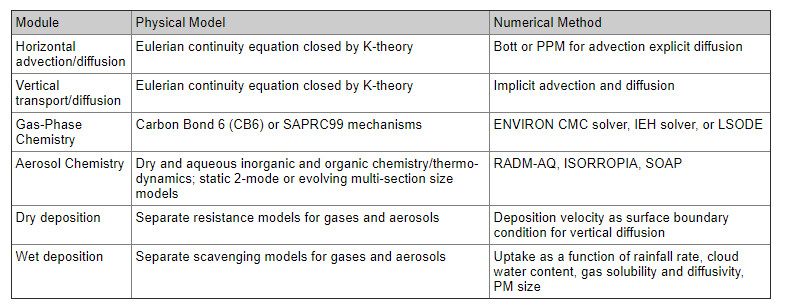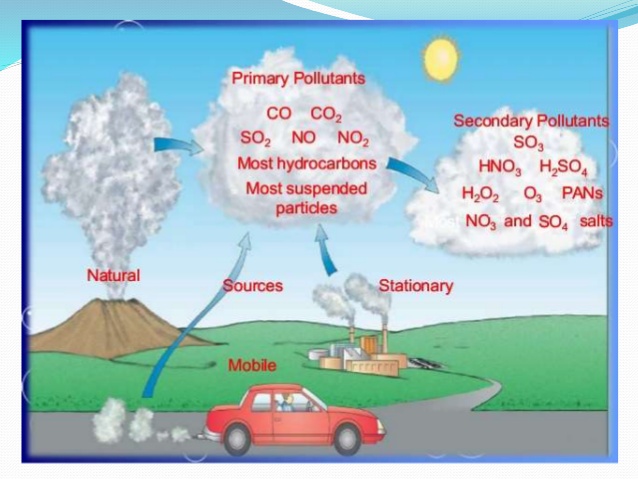Basic Information
The Comprehensive Air quality Model with extensions (CAMx) is a three-dimensional photochemical grid dispersion model that allows for an integrated “one-atmosphere” assessment of gaseous and particulate matter (PM) air pollution over many scales ranging from urban to super-regional. Recently, CAMx Version 4 was released including a ”one-atmosphere” particulate matter (PM) module that treats PM in two sections, as fine (particles smaller than 2.5 microns in diameter) and coarse (particles larger than 2.5 microns in diameter) particles. The CAMx4 PM module includes complete inorganic aerosol thermodynamics (ISORROPIA), semi-volatile secondary organic aerosol equilibrium (SOAP), a bulk-phase aqueous chemistry module (RADM) and a new wet-deposition scheme. A more detailed “full-science” PM treatment has also been implemented in CAMx (PMCAMx) where the particle size distribution is represented as a number of fixed size sections (e.g., ten sections) and also includes a variable size resolution aqueous-phase chemistry module to better describe cloud droplets of different sizes as well as options for fully dynamic, equilibrium (ISORROPIA) and hybrid aerosol thermodynamics.
The Comprehensive Air-quality Model with Extensions (CAMx) is a three-dimensional multi-scale photochemical grid model1 that is publicly available (www.camx.com) without fees or restrictions on model application. CAMx was developed with all new code during the late 1990s using modern and modular coding practices. This has made the model an ideal platform for extension to treat a variety of air quality issues including ozone, particulate matter (PM), visibility, acid deposition, air toxics, and mercury. The flexible CAMx framework has also made it a convenient and robust host model for the implementation of “probing tool” techniques such as Process Analysis, the Decoupled Direct Method (DDM) and the Ozone Source Apportionment Technology (OSAT).2,3,4 The Coordinating Research Council (CRC) have sponsored ENVIRON, together with Sonoma Technology, Inc. (STI) and Carnegie Mellon University (CMU), to add state-of-the-science algorithms for aerosol modeling to CAMx to create a new particulate matter model called PMCAMx (version 3.01).
In addition to the features it shares with most photochemical grid models, some of the most notable features of CAMx are:
-
Two-way grid nesting
-
Flexi-Nesting, which allows for reconfiguration of nested grids during a simulation
-
Multiple gas phase chemistry mechanism options (CB6, CB05, SAPRC99)
-
Multiple gas phase chemistry solver options (EBI, IEH, LSODE)
-
Advanced external photolysis model (TUV) with in-line cloud and aerosol adjustments
-
Two particle size treatments (modal and sectional)
-
Plume-in-Grid (PiG) module for sub-grid treatment of selected point sources
-
Multiple dry deposition options (Wesely89, Zhang03)
-
Probing Tools:
-
Ozone and Particulate Source Apportionment Technology (OSAT/PSAT)
-
Decoupled Direct Method (DDM/HDDM) for source sensitivity of ozone and other species
-
Multiple Process Analysis (PA) options
-
Reactive Tracer (RTRAC/RTCMC) Source Apportionment for air toxics
-
Mass conservative and consistent transport numerics:
-
Multiple horizontal advection solvers (PPM, Bott)
-
Multiple vertical diffusion methods (K-theory, ACM2)
-
Parallel processing using Open-MP on shared-memory systems
-
Parallel processing using Message Passing Interface (MPI) on distributed-memory systems
Model output
CAMx produces gridded time-averaged concentration output files for each time step (usually hourly). The output can contains just surface layer fields or entire three-dimensional fields, both for the master grid, and a all fine grid nests together.
 Basic physical processes
Basic physical processes



 Basic physical processes
Basic physical processes





